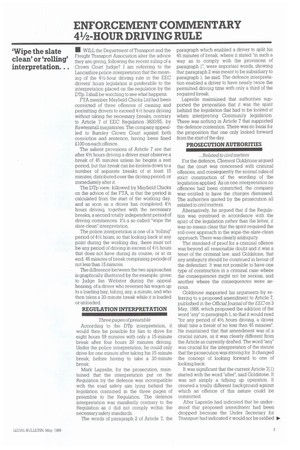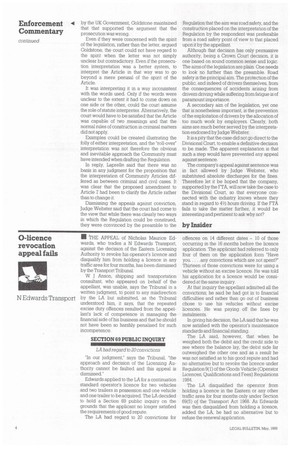ENFORCEMENT COMMENTARY 41/2-HOUR DRIVING RULE
Page 113

Page 114

If you've noticed an error in this article please click here to report it so we can fix it.
• WILL the Department of Transport and the Freight Transport Association alter the advice they are giving, following the recent ruling of a Crown Court Judge? I am referring to the Lancashire police interpretation that the meaning of the 41/2-hour driving rule in the EEC drivers hours legislation is preferable to the interpretation placed on the regulation by the DTp. I shall be watching to see what happens.
FTA member Mayfield Chicks Ltd had been convicted of three offences of causing and permitting drivers to exceed 41/2 hours driving without taking the necessary breaks, contrary to Article 7 of EEC Regulation 3820/85, by Rawtenstall magistrates. The company appealled to Burnley Crown Court against both conviction and sentence, having been fined £100 on each offence.
The salient provisions of Article 7 are that after 41/2 hours driving a driver must observe a break of 45 minutes unless he begins a rest period, but that break can be broken down to a number of separate breaks of at least 15 minutes, distributed over the driving period, or immediately after it.
The D.Tp view, followed by Mayfield Chicks on the advice of the FTA, is that the period is calculated from the start of the working day, and as soon as a driver has completed 41/2 hours driving, together with the necessary breaks, a second totally independent period of driving commences. It's a so-called "wipe the slate clean" interpretation.
The police interpretation is one of a 'rolling" period of 41/2 hours, so that looking back at any point during the working day, there must not be any period of driving in excess of 41/2 hours that does not have during its course, or at its end, 45 minutes of break comprising periods of not less than 15 minutes.
The difference between the two approaches is graphically illustrated by the example, given to Judge Ian Webster during the appeal hearing, of a driver who reverses his wagon up to a loading bay, taking, say, a minute, and who then takes a 30-minute break while it is loaded or unloaded.
According to the DTp interpretation, it would then be possible for him to drive for eight hours 59 minutes with only a 15-minute break after four hours 29 minutes driving. Under the police interpretation, he could only drive for one minute after taking his 15-minute break, before having to take a 30-minute break.
Mark Laprelle, for the prosecution, maintained that the interpretation put on the Regulation by the defence was incompatible with the road safety aim lying behind the legislation contained in the three pages of preamble to the Regulation. The defence interpretation was manifestly contrary to the Regulation as it did not comply within the necessary safety standards.
The words of paragraph 2 of Article 7, the paragraph which enabled a driver to split his 45 minutes of break, where it stated "in such a way as to comply with the provisions of paragraph 1", were important words, showing that paragraph 2 was meant to be subsidiary to paragraph 1, he said. The defence interpretation enabled a driver to have nearly twice the permitted driving time with only a third of the required break.
Laprelle maintained that authorities supported the proposition that it was the spirit behind the legislation that had to be looked at when interpreting Community legislation, There was nothing in Article 7 that supported the defence contention There was no basis for the proposition that one only looked forward from the start of the day.
For the defence, Clement Goldstone argued that the court was concerned with criminal offences, and consequently the normal rules of strict construction of the wording of the legislation applied. As on one interpretation no offences had been committed, the company was entitled to have the charges dismissed. The authorities quoted by the prosecution all related to civil matters.
Alternatively, he argued that if the Regulation was construed in accordance with the spirit of the legislation rather than the letter, it was no means clear that the spirit required the roll-over approach to the wipe-the-slate-clean approach. There was clearly ambiguity.
The standard of proof for a criminal offence was beyond all reasonable doubt and it was a tenet of the criminal law, said Goldstone, that any ambiguity should be construed in favour of the defendant. It was not possible to have one type of construction in a criminal case where the consequences might not be serious, and another where the consequences were serious.
Goldstone supported his arguments by referring to a proposed amendment to Article 7, published in the Official Journal of the EEC on 3 May, 1988, which proposed the addition of the word 'any'' to paragraph 1, so that it would read "for any period of 41/2 hours driving, a driver shall take a break of no less than 45 minutes". He maintained that that amendment was of a crucial nature, as it was clearly different from the Article as currently drafted. The word "any" was crucial for the interpretation of the statute that the prosecution was striving for. It changed the concept of looking forward to one of looking back.
It was significant that the current Article 7(1) started with the word "after", said Goldstone. It was not simply a tidying up operation. It created a totally different background against which an offence of this nature could be committed.
After Laprelle had indicated that he understood that proposed amendment had been dropped because the Under Secretary for Transport had indicated it would not be ratified by the UK Government, Goldstone maintained that that supported the argument that the prosecution was wrong.
Even if they were concerned with the spirit of the legislation, rather than the letter, argued Goldstone, the court could not have regard to the spirit when the letter was not simply unclear but contradictory. Even if the prosecution interpretation was a better system, to interpret the Article in that way was to go beyond a mere perusal of the spirit of the Article.
It was interpreting it in a way inconsistent with the words used. Only if the words were unclear to the extent it had to come down on one side or the other, could the court assume the role of statute interpreter. Alternatively, the court would have to be satisfied that the Article was capable of two meanings and that the normal rules of construction in criminal matters did not apply.
Examples could be created illustrating the folly of either interpretation, and the "roll-over" interpretation was not therefore the obvious and inevitable approach the Community must have intended when drafting the Regulation.
In reply, Laprelle said that there was no basis in any judgment for the proposition that the interpretation of Community Articles differed as between criminal and civil cases. It was clear that the proposed amendment to Article 7 had been to clarify the Article rather than to change it.
Dismissing the appeals against conviction, Judge Webster said that the court had come to the view that while there was clearly two ways in which the Regulation could be construed, they were convinced by the preamble to the 1111 THE APPEAL of Nicholas Maurice Edwards, who trades a N Edwards Transport, against the decision of the FAstern Licensing Authority to revoke his operator's licence and disqualify him from holding a licence in any traffic area for four months, has been dismissed by the Transport 'Tribunal.
W J Anson, shipping and transportation consultant, who appeared on behalf of the appellant, was unable, says the Tribunal in a written judgment, to point to any misdirection by the LA but submitted, as the Tribunal understood him, it says, that the repeated excise duty offences resulted from the appellant's lack of competence in managing the financial side dims business and that he should not have been so harshly penalised for such incompetence "In our judgment," says the Tribunal, "the approach and decision of the Licensing Authority cannot be faulted and this appeal is dismissed.'
Edwards applied to the LA for a continuation standard operator's licence for two vehicles and two trailers in possession and one vehicle and one trailer to be acquired. The LA decided to hold a Section 69 public inquiry on the grounds that the applicant no longer satisfied the requirements of good repute.
The LA had regard to 20 convictions for Regulation that the aim was road safety, and the construction placed on the interpretation of the Regulation by the respondent was preferable from a road safety point of view to that placed upon it by the appellant.
Although that decision has only persuasive authority, being a Crown Court decision, it is one based on sound common sense and logic. The aims of the legislation are plain. One needs to look no further than the preamble. Road safety is the principal aim. The protection of the public, and indeed of drivers themselves, from the consequences of accidents arising from drivers driving while suffering from fatigue is of paramount importance.
A secondary aim of the legislation, yet one that is nonetheless important, is the prevention of the exploitation of drivers by the allocation of too much work by employers. Clearly, both aims are much better served by the interpretation endorsed by Judge Webster.
It is a pity that the case did not go direct to the Divisional Court, to enable a definitive decision to be made. The apparent explanation is that such a step would have prevented any appeal against sentence.
The company's appeal against sentence was in fact allowed by Judge Webster, who substituted absolute discharges for the fines. Therefore let it be hoped that the company, supported by the FTA, will now take the case to the Divisional Court, so that everyone connected with the industry knows where they stand in regard to 4½ hours driving. If the FTA fails to take the matter further, it would be interesting and pertinent to ask why not?
offences on 14 different dates 10 of those occurring in the 16 months before the licence application. The applicant had referred to only four of them on the application form "Have you any convictions which are not spent?" Thirteen of those convictions were for using a vehicle without an excise licence. He was told his application for a licence would be considered at the same inquiry.
At that inquiry the appellant admitted all the convictions; he said he had got in to financial (-faculties and rather than go out of business chose to use his vehicles without excise licences. He was paying off the fines by instalments.
In giving his decision, the LA said that he was now satisfied with the operator's maintenance standards and financial standing.
The LA said, however, that when he weighed both the debit and the credit side to see where the balance lay, the debit side far outweighed the other one and as a result he was not satisfied as to his good repute and had no alternative but to revoke the licence under Regulation 9(1) of the Goods Vehicle (Operator Licences, Qualifications and Fees) Regulations 1984.
The LA disqualified the operator from holding a licence in the Eastern or any other traffic area for four months only under Section 69(5) of the Transport Act 1968. As Edwards was then disqualified from holding a licence, added the LA, he had no alternative but to refuse the renewal application.
























































































































